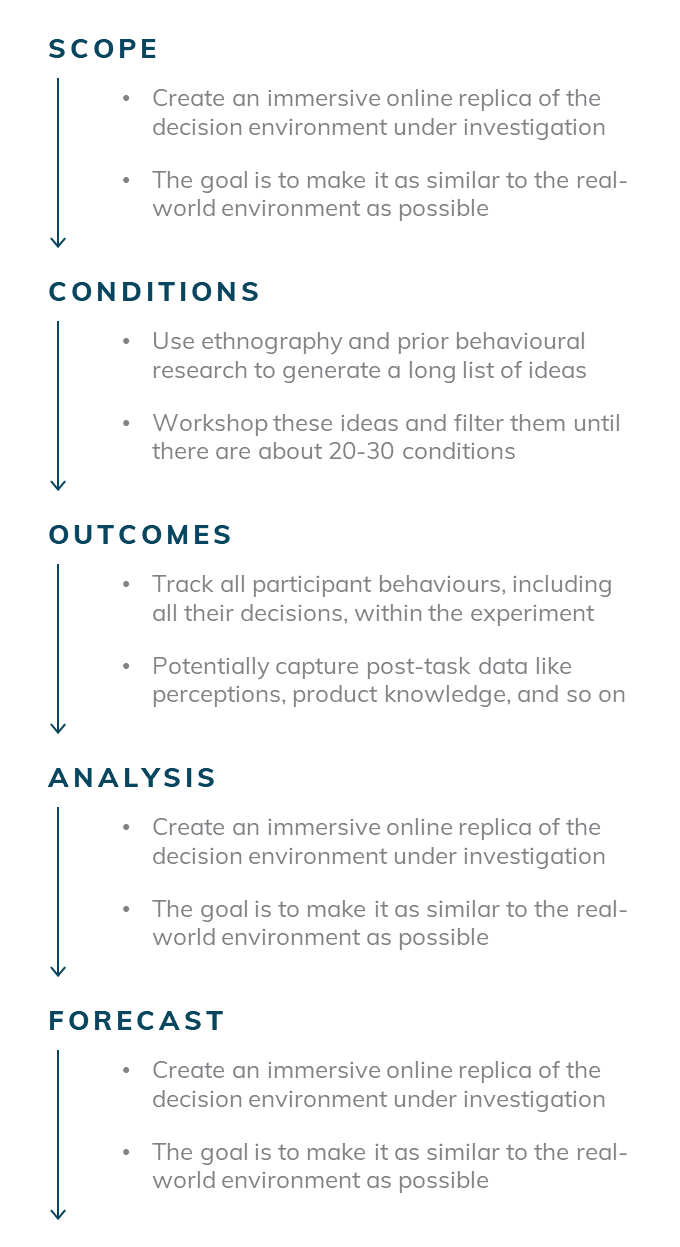Behaviourlab: Predicting People, Optimising Corporate Strategy
Posted: 03/08/2020


Live trials solve problems found with traditional research approaches. But they are expensive, limited in scope, and take ages. Behaviourlab solves these problems by replicating realistic decision environments in a randomised controlled trial setting. Consequently, Behaviourlab accurately forecasts the commercial effects of alternative strategies.
Commercial performance is driven by better decision-making which, in turn, depends on better foresight. Unfortunately, predicting people, such as consumers, is difficult. First, they either don’t know or won’t tell how they’re going to behave. Second, if you change their choice environment, it will dramatically change that behaviour. So traditional research methods like self-report (e.g. focus groups) and revealed preference (e.g. max-diff or conjoint) have limited accuracy.
Live trials, like A/B testing or shelf-edge trials, offer a partial solution. They avoid the pitfalls because they involve real-world behaviour in the actual decision environment. But live trials also have their limitations. There are many commercial decisions you simply cannot live trial, such as those involving unbuilt features, radical price or proposition variants, competitor changes and so on. To solve these problems we developed Behaviourlab.
Behaviourlab is an immersive, online, behavioural approach that replicates, as closely as possible, the real-world decision environment that people experience in practice. Figure 1 provides more details. Like A/B testing, Behaviourlab is a randomised controlled trial method that involves recruiting participants to undertake different versions of a given task (e.g. an acquisition journey or churn decision). The different experimental conditions can then be analysed to yield behavioural models that forecast the commercial effects of alternative strategies.
Figure 1: Five Stages of Behaviourlab

As such, the Behaviourlab approach offers various benefits. Based on client feedback, these are the five most powerful:
- Accurate: To quote one client: it’s “extraordinarily accurate”. Because Behaviourlab replicates the real-world decision environment and is based on behaviour it avoids the pitfalls cited earlier. It’s also a “cleanroom” that excludes all the field noise that comes with live trialling.
- Omnipropriate: Being custom-built and confidential, Behaviourlab can address questions that you can’t or wouldn’t live trial. For example, you can test extremes (e.g. big price shifts), innovations (e.g. new products or journeys), or competitive changes (e.g. new entrants).
- Informed: Behaviourlab has an explicit scenario creation stage that draws on existing behavioural research. The extensive list of effects identified in the literature helps generate better ideas for testing and ensures focus on those with a higher chance of success.
- Panoptic: Conjoint or live trials can only measure preferences or what’s observable in your customer data. Behaviourlab can be used to capture all aspects of participant behaviour, together with their knowledge, perceptions and any relevant personal details or real-world behaviours.
- Rapid-Scalable: Behaviourlab isn’t run on a live-system, so can be executed quickly and circumvents any Dev roadblocks. Being cheaper than live trials, it can also be used to test more conditions. As such, Behaviourlab can support rapid, extensive, iterative design cycles.
As Jeff Bezos, the founder of Amazon, once said “if you double the number of experiments you do, you’re going to double your inventiveness.” Behaviourlab represents a flexible and effective tool for increasing commercial innovation and thereby optimising corporate strategy.
Get in Touch if you would like to find out more.